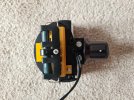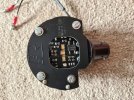So I've managed to get hold (legally, I may add!) of a signal head to use for training purposes. The signal is fitted with these LED lamps. I've got them to light with a 12v power supply, but is that the correct voltage for the lamp? Is there a name for the socket that the bulb fits into? So far I've only managed to get the lamp to light using the spade connectors, rather than the connectors at the base of the lamp. If anyone has any pointers as to the best way to get the bulb to light, please let me know!
-
Our booking engine at tickets.railforums.co.uk (powered by TrainSplit) helps support the running of the forum with every ticket purchase! Find out more and ask any questions/give us feedback in this thread!
You are using an out of date browser. It may not display this or other websites correctly.
You should upgrade or use an alternative browser.
You should upgrade or use an alternative browser.
Signal head lamp
- Thread starter skyhigh
- Start date
- Status
- Not open for further replies.
Sponsor Post - registered members do not see these adverts; click here to register, or click here to log in
R
RailUK Forums
I'm pretty sure these bulbs are designed to plug into the standard lamp socket for filament bulbs, as the base has the three location prongs associated with the older bulbs. But it looks as if the base is completely plastic, so the contacts in the original socket wouldn't work, hence the flying leads with spade connectors. The standard bulb worked off a nominal 12v (AC) but was usually under-run by a volt or so to prolong life.
Edit: Looking at a magnified view of the front showing the 5 LEDS also shows a full-wave rectifier is included in the design, so the applied voltage could be AC or DC. I assume the heavy-duty resistors on the back are to pass sufficient current to operate the filament proving relay as the LEDs would not pass sufficient current on their own.
Edit: Looking at a magnified view of the front showing the 5 LEDS also shows a full-wave rectifier is included in the design, so the applied voltage could be AC or DC. I assume the heavy-duty resistors on the back are to pass sufficient current to operate the filament proving relay as the LEDs would not pass sufficient current on their own.
Last edited:
That's helpful, thank you. I can see that the transformer has an input of 110v and output of 11v and 12v - the bulb lights perfectly on 12v but it got rather hot so I didn't want to burn it out accidentally! That would fit with the resistor passing the additional current for the proving circuitry though, as I'm aware LEDs are used for reasons of decreased maintenance rather than reducing energy consumption.I'm pretty sure these bulbs are designed to plug into the standard lamp socket for filament bulbs, as the base has the three location prongs associated with the older bulbs. But it looks as if the base is completely plastic, so the contacts in the original socket wouldn't work, hence the flying leads with spade connectors. The standard bulb worked off a nominal 12v (AC) but was usually under-run by a volt or so to prolong life.
Edit: Looking at a magnified view of the front showing the 5 LEDS also shows a full-wave rectifier is included in the design, so the applied voltage could be AC or DC. I assume the heavy-duty resistors on the back are to pass sufficient current to operate the filament proving relay as the LEDs would not pass sufficient current on their own.
Having had a closer look at the socket in the signal you're right in that the plastic base is just to support the lamp in the holder, and the leads are for powering the lamp.
Thanks again for your help.
Glad to have been of help. If your training needs don't require the lamp proving circuitry to be active, you could disconnect the two resistors to save on power consumption? (The original SL34 twin-filament bulbs were rated at 24W, so took around 2A current - the proving relay was easy to operate at that current. But with the much lower consumption of LEDs, the two resistors probably have to dissipate something in the region of 15-20W?)That's helpful, thank you. I can see that the transformer has an input of 110v and output of 11v and 12v - the bulb lights perfectly on 12v but it got rather hot so I didn't want to burn it out accidentally! That would fit with the resistor passing the additional current for the proving circuitry though, as I'm aware LEDs are used for reasons of decreased maintenance rather than reducing energy consumption.
Having had a closer look at the socket in the signal you're right in that the plastic base is just to support the lamp in the holder, and the leads are for powering the lamp.
Thanks again for your help.
At St Albans South our 1970s colour light signal demo was fitted with 3.5W MR16 LED bulbs (the 50mm diameter reflector bulbs) to give low current consumption and a broader spread of light to make viewing by visitors* easier. See our 2020 News Page for some photos of this conversion.
*When we eventually reopen!
Last edited:
I don't need the proving circuitry so I might give that a go, the idea is just to use a signal head with a Raspberry Pi to control it to give a visual representation of signal sequences for trainees - similar to what you have at St Albans!Glad to have been of help. If your training needs don't require the lamp proving circuitry to be active, you could disconnect the two resistors to save on power consumption? (The original SL34 twin-filament bulbs were rated at 24W, so took around 2A current - the proving relay was easy to operate at that current. But with the much lower consumption of LEDs, the two resistors probably have to dissipate something in the region of 15-20W?)
At St Albans South our 1970s colour light signal demo was fitted with 3.5W MR16 LED bulbs (the 50mm diameter reflector bulbs) to give low current consumption and a broader spread of light to make viewing by visitors* easier. See our 2020 News Page for some photos of this conversion.
*When we eventually reopen!
Using MR16 bulbs was my original idea, so it's interesting to see your conversion. I used to live in Harpenden and never got around to visiting your box, sadly. Maybe the next time I'm down seeing family if you're back open!
- Status
- Not open for further replies.


